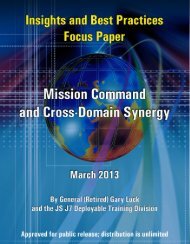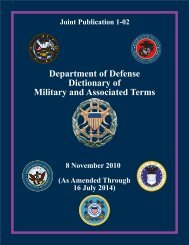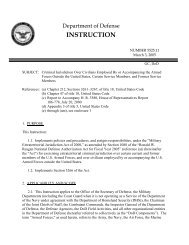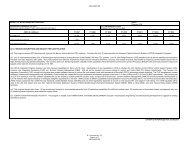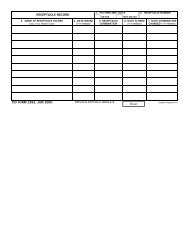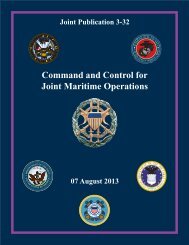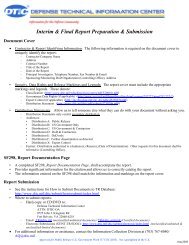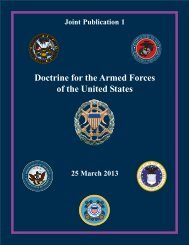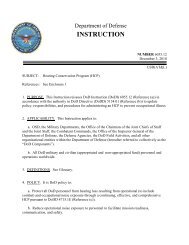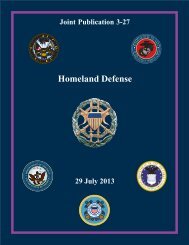JP 3-16, Multinational Operations - Defense Technical Information ...
JP 3-16, Multinational Operations - Defense Technical Information ...
JP 3-16, Multinational Operations - Defense Technical Information ...
Create successful ePaper yourself
Turn your PDF publications into a flip-book with our unique Google optimized e-Paper software.
Chapter II<br />
multinational command. Meetings with the MNFC provide the setting for open, candid input<br />
from participating nations.<br />
f. LN and parallel command structures can exist simultaneously within a coalition. This<br />
situation occurs when two or more nations or organizations serve as controlling elements for<br />
a mix of international forces. The command arrangement used by the Gulf War coalition<br />
(see Figure II-6) provides a good example of the intricate web of command structures<br />
possible. In that case, the US performed as the LN for a coalition of non-Arab countries<br />
while Saudi Arabia functioned as the LN for the Arab coalition members. A friendly forces<br />
coordinating council (since renamed to coalition coordination center [CCC]) provided the<br />
coordination conduit between the non-Arab (US-led) forces and the Arab/Islamic (Saudi-led)<br />
command structures. Terms in the figure reflect the terminology used in the operation.<br />
g. Figures II-7 through II-10 show examples of coalition command structures from<br />
Afghanistan ISAF (Figures II-7 and II-8), the NATO Balkans Stabilization Force (Figure II-<br />
9), and the Balkans European Force Command (Figure II-10). In the Balkans, when the<br />
European Union (EU) assumed the mission from NATO, NATO continued to maintain a<br />
military HQ and a place in the command chain as well, with a continued US presence in the<br />
country. These diagrams highlight the evolution of multinational command structures,<br />
especially those involving IGO such as NATO, the EU, or the UN. These organizations add<br />
a layer of complexity to the command structure as nations have to answer to both the IGO<br />
chain of command as well as their national political leadership.<br />
6. <strong>Multinational</strong> Coordination<br />
There are two key structural enhancements that should improve the coordination of<br />
MNFs: a liaison network and coordination centers.<br />
a. Liaison Network. Effective liaison is vital in any MNF. Differences in doctrine,<br />
organization, equipment, training, and national law demand a robust liaison structure to<br />
facilitate operations. Not only is the use of liaison an invaluable confidence-building tool,<br />
but it is also a significant source of information for the MNFC. During multinational<br />
operations, US forces should establish liaison early with forces of each nation, fostering a<br />
better understanding of mission and tactics, facilitating the ability to integrate and<br />
synchronize operations, assisting in the transfer of vital information, enhancing mutual trust,<br />
and developing an increased level of teamwork.<br />
(1) Liaison is often accomplished through the use of liaison teams. These teams<br />
should be knowledgeable about the structure, capabilities, weapons systems, logistics,<br />
communication systems, and planning methods that are employed within their commands.<br />
Liaison requirements for US forces participating in multinational operations are usually<br />
greater than anticipated or staffed. Personnel liaison requirements should be identified early<br />
during the planning process and staffed accordingly. Team members should be language<br />
qualified or provided linguist support. Although professional knowledge and functional<br />
expertise are key factors to successful liaison operations, understanding language and culture<br />
are equally important and influential.<br />
II-8 <strong>JP</strong> 3-<strong>16</strong>



